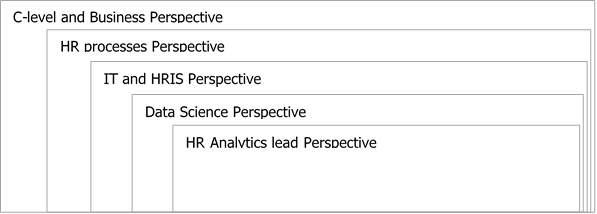I’ve witnessed a lot of interest in the domain of People analytics this year, among HR and other C-level managers that I met in Tel Aviv. At some point in any networking conversation, I’ve always been asked to explain how different People analytics is, from the traditional Organizational Research that I’ve conducted for more than two decades now. A comprehensive definition of the “People Analytics” field would be useful to clarify the difference. Unfortunately, I keep finding myself lost in vague and exhausting explanations since it is still hard to describe the complexity of People Analytics in one or a few clear sentences.
People Analytics is a growing field. Yet, it is not mature. Many terms in this domain are quite fluid, especially among HR practitioners. I believe that we still lack parsimonious definitions that would lead us through many blurred concepts in this professional raising area. Yet, I keep looking.
A search for a definition
Definitions are found all over the web, you may say. Certainly, Google will give you 27 million results in less than a second. The first in my google search would be “Technopedia”, which refers HR analytics to “applying analytic processes to the HR department, in the hope of improving employee performance and therefore getting a better ROI.” According to this definition, the objective is to provide insight into business processes through data analysis, and base relevant decisions on data, for improving these processes.
However, this short definition is neglecting many features of People analytics in practice. For instance, it ignores the massive amount of employee data, which is not directly related to business processes and performance but may raise an important understanding of it. “Bersin by Deloitte” uses the term Talent analytics to clarify “the use of measurement and analysis techniques to understand, improve, and optimize the people side of the business.” Its definition details many kinds of data, e.g., demographics, job history, training, assessments, and compensation, which “can be correlated and matched to many different types of business data to help companies to understand profiles and behaviors which create high performance”.
Bersin’s definition is indeed broader. Nevertheless, it implies almost nothing about the time point of view. Specifically, do we use data elements for inference (i.e., explaining past or present results), or do we use them for prediction (i.e., learning something about future results)? Although Bersin suggests a framework to measure the analytics maturity, starting low at “operational reporting” and ending high at “predictive analytics”, its core definition actually does not include the time perspective. The importance of time perspective is nicely stated in the book “People Analytics in the Era of Big Data: Changing the Way You Attract, Acquire, Develop, and Retain Talent”, by J.P. Isson and J.S. Harriott. As Isson and Harriet put it, “People Analytics has the most impact on the organization when it is forward-looking – not backward-looking. In other words, it is most useful when it is predictive and provides a lens into the future regarding likely business outcomes”.
Five perspectives of an expanded definition
So far, just by scratching the surface, it is clear that People Analytics is much beyond the HR department scope, as opposed to old-school organizational researches. It is about business performance in general, it is involved with different kinds of data, and it is relevant not just for inference but rather for prediction. However, these definitions of People analytics are not sufficient, in my opinion, to fully distinguish between Organizational Research and People Analytics.
The complexity of the People Analytics domain, let alone the complexity of its parsimonious definitions, is clearly demonstrated in an inspiring article, recently published by our colleague Lyndon Sundmark. Trying to answer the huge question of “how do I get started in the field of HR Analytics”, Sundmark lists the building blocks of People analytics, which domain experts must be familiar with. These building blocks include HR functions and business processes, Information technology and HR information systems, Business statistical analysis, HR measurement and metrics, HR operations, HR decision making and policies, and Data Science framework.
Indeed, a multidisciplinary long-long list. Reading Sundmark’s article, I suddenly realized that the definition which I’m looking for should have some kind of a top-down structure, describing People analytics through different organizational perspectives. A top-down structured definition may emphasize not only the complexity of this field but also its vast influence on different aspects of the activity in the organization.
Explicitly, I suggest to include five perspectives in any definition of People Analytics: Starting from C-level and business perspective, go through HR processes and IT and HRIS, and end-up with a Data science perspective and the role of the People analytics lead:
I believe that such a scheme may serve as a diagnostic guideline when approaching a new organization (and not only be of assistance next time I try to explain the differences between People Analytics and the traditional Organizational Research domain). Notice that in effect, each level in the suggested structure is influencing and being influenced by the nature of the level on its top. Hence, such a guideline may deepen the understanding of the organizational challenges in regards to People Analytics, and point to the core opportunities for different roles in the HR team.
So, how would you define People analytics? How does this definition structure would facilitate it? I welcome your suggestions in comments.
An overview of future role of HR leaders in improving business performance by informed decisions about people based on data. People Analytics transforming HR; The Role of People Analytics Leader; Case Studies and Simulations; Emerging trends of HR tech.









6 thoughts on “The Complexity of People Analytics Resolved: 5 Perspectives of Definition”
Littal’s answer on Quora in this subject:
https://www.quora.com/Is-people-analytics-different-from-HR-analytics/answer/Littal-Shemer-Haim?srid=iYu2
“HR has long focused on achieving operational excellence”, says John Schwarz , CEO of Visier , in his article The Disconnect between People and Business Strategy . “Systems such as payroll, performance management, learning and development, compensation and benefits management, and applicant tracking generate lots of data but are not capable of even effective operational reporting, much less comprehensive analytics. The underlying technology of transactional systems, designed to process one record at a time, is simply not suited for any meaningful analytics.” The connection between the two upper layers in the definition of People Analytics, suggested in this article, is validated by Schwarz insights: “When the CEO and CHRO are in sync and using data collected by HR, the impact of the workforce on business results becomes clearer and leadership is able to make better informed strategic decisions.”
Hello Littal, we are a UK based Predictive People Analytics software company. Interestingly, our first software iteration of our platform was developed in Israel around 2007-8 but we took that back in-house in 2010. Since then we have been in the journey to define (in our minds and in the market) what People Analytics means and how it delivers value to organisations and teams (a broader definition of groups of people working together for paid labour or otherwise). In our experience the terms Talent/People/HR Analytics are pretty much interchangeable in the minds of your average HRD/CPO globally and as such we try instead to focus on the issue from a human perspective and less from an organisational theory / business management / academic point of view. By that we mean honing in on the value equation: what value would this bring in equal measure to the entire cyclical value chain spanning across business owner / employer / employee / society? For us it is firmly rooted in ‘seeing potential’. In an HR world the next 10-20 years AI & Machine Learning will come to dominate the landscape of talent hiring, firing and performance. Many millions of jobs will disappear and never return – many others (hopefully enough but not certainly) will re-emerge to replace those lost. In the middle of this seismic shift of labour, the new frontier that will be central to this challenge for humanity will centre around seeing and understanding human potential. Otherwise, what is left? It’s the last great mystery of humanity we face. If there’s nothing left that the machines can’t do – then what’s left for us? Less dramatically speaking and in a business context, the new frontier of human endeavour will require a contract between employer and employee based not so much on “what can I do’ and more on “what could I do’ as a fundamental value transaction. The potential of what a human can bring to any enterprise or endeavour will become the currency of the era. Therefore, it is logical that understanding and calibrating the notional and actual value of someone’s potential will be critical. Otherwise how could anyone make a decision on such an important transaction? Subjective opinion? Gut feel? Consensus? That’s the system we have at the moment and we all know how desperately flawed and inefficient a human HR process that is. So we see People Analytics as the process by which humans use machines to help them make the best informed decisions they can about people and their potential. It helps us see potential. Because right now – we can’t. And we are going to need to.
Hi Tim, Thanks for sharing this perspective. I’m not sure if you noticed, but this article is 2.5 years old… Your comment really represents the huge development in the conversation within the People Analytics domain. So, I’d love to quote this in a future blog. Would you mind?
Formally speaking, people analytics should probably be defined by it’s uniqueness – the process and result of using numerical methods to describe humans. However, it’s followed by the really interesting questions such as “why are we doing people analytics”, and that’s, if I understood correctly, the purpose of dividing the definition to 5 different perspectives.
In that context, Tim had an interesting comment, in particular the part about doing people analytics not to understand “what can I do”, but to understand “what could I do”
Thanks, Ze’ev Sovik! People Analytics is not only about numerical methods. Qualitative research is also important, along with complementary tech solutions, e.g., text analysis, graphs methods, and more. To revise the domain definition I would mention every kind of stakeholders, including employees.
Comments are closed.